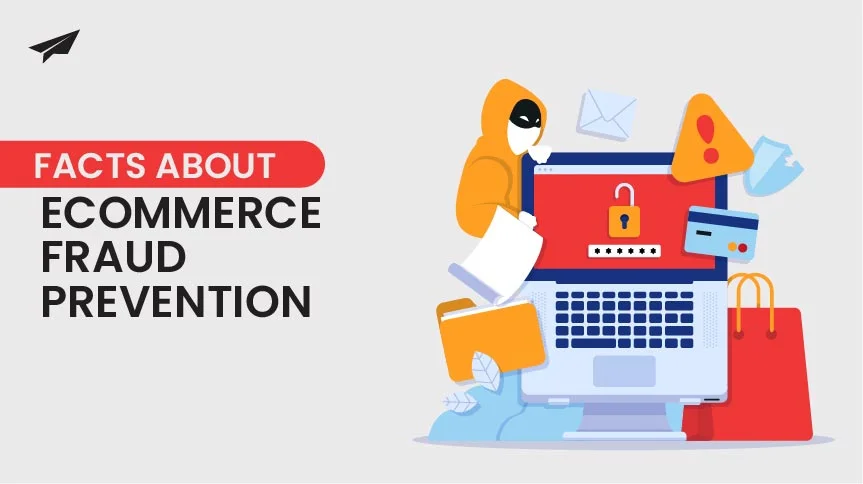Facts You Need to Know for eCommerce Fraud Prevention
Fraud prevention is identifying and mitigating fraudulent activities to reduce financial losses and safeguard your reputation. In this blog post, we’ll cover some key facts that you need to know about fraud prevention for eCommerce businesses. With the growth of eCommerce, the risk of fraudulent activities has also increased significantly. Therefore, as an eCommerce business owner, you must proactively prevent fraud and protect your business. We’ll explore how understanding the different types of fraud, recognizing the warning signs of eCommerce fraud, staying up to date with fraud detection technologies, hiring third party risk management, educating staff on eCommerce fraud protection, and implementing AI security can all help to prevent fraudulent activities and ensure the long-term success of your eCommerce business.

Understanding the types of fraud
Understanding the different types of fraud is critical in preventing eCommerce fraud. Fraudulent activities can be classified into several categories: identity theft, account takeover, card testing, triangulation fraud, refund fraud, and chargeback fraud.
Identity theft is fraud in stealing personal information, such as name, address, birth date, and social security number, to assume someone else’s identity. This type of fraud is typically used to open new credit accounts, make purchases, or apply for loans.
Account takeover is a fraud where a fraudster can access a legitimate user’s account using their login credentials. Once they have access, the fraudster can make purchases, change the account information, and transfer funds without the user’s knowledge.
Card testing is a type of fraud where a fraudster tests a stolen credit card by making small purchases to verify if it is still active. Once they have confirmed that the card is happening, they can make larger purchases.
Triangulation fraud is when a fraudster creates a fake online store to sell low-quality products. The fraudster then purchases the same products from a legitimate online store and has them shipped directly to the customer. The customer receives the product but is unaware they were part of a fraudulent scheme.
Refund fraud is a type of fraud where a customer requests a refund for a product they never purchased. The fraudster stole credit card information to make the purchase and then requested a refund to a different account.
By understanding the different types of fraud, eCommerce businesses can implement targeted prevention strategies to reduce the risk of fraudulent activities. First, however, it’s important to stay vigilant and monitor your eCommerce transactions for suspicious activities.
Recognizing the Warning Signs of eCommerce Fraud
Recognizing the warning signs of eCommerce fraud is critical to fraud prevention. By identifying suspicious activities, eCommerce businesses can take appropriate action to prevent fraud before it occurs. Here are some common warning signs to look out for:
If a customer places a charge significantly more than average, it could be a red flag for fraud. Fraudsters often try to make large purchases to maximize their financial gain.
Fraudsters may request rush delivery or overnight shipping to receive the goods before the fraud is discovered. Be cautious of orders with expedited shipping, especially from new or unverified customers.
If it differs from the billing address, it could be a warning sign of fraud. Fraudsters often use a different shipping address to avoid detection.
If a customer behaves unusually, such as making multiple attempts to place an order, entering incorrect or inconsistent information, or using various credit cards, it could be a sign of fraud.
Certain products, such as electronics, luxury items, and high-end goods, are more susceptible to fraud. Be extra cautious when processing orders for these products.
If the IP address used to place an order is from a high-risk country or has a history of fraudulent activity, it could be a warning sign of fraud.
Be cautious of orders paid for with unusual payment methods, such as prepaid debit cards or wire transfers.
By being aware of these warning signs, eCommerce businesses can take steps to prevent fraudulent activities before they occur. It’s necessary to have a system in place for reviewing orders and verifying the identity of customers, especially for high-risk transactions. Regularly monitoring your eCommerce transactions for suspicious activity is crucial for effective fraud prevention.
Hiring Third Party Risk Management
Third party risk management involves outsourcing fraud prevention to a specialized agency that can manage fraud risks on your behalf. These agencies have the expertise and technology to detect and prevent fraudulent activities. By hiring a third party risk management agency, you can focus on growing your eCommerce business while leaving fraud prevention to the experts.
Educating Staff on eCommerce Fraud Protection
It’s essential to educate them on eCommerce fraud protection as your staff plays a crucial role in preventing eCommerce fraud protection. This includes providing them with training on how to identify fraudulent activities, how to handle suspicious orders, and how to report potentially fraudulent activities to management. In addition, educating your staff can create a culture of vigilance against eCommerce fraud protection.
Staying Up to Date with Fraud Detection Technologies
Businesses must stay updated with the latest fraud detection technologies as eCommerce fraud becomes increasingly sophisticated. Fraud prevention technologies use advanced algorithms and machine learning to identify fraudulent activities and prevent them from occurring. Here are some of the latest technologies used for fraud detection:
AI can identify fraudulent transactions by analyzing patterns and behaviors. It can also help identify unusual activities and flag them for further review.
Machine learning algorithms can analyze large datasets and identify patterns that may indicate fraud. This technology is constantly learning and improving, making it an effective tool for fraud detection.
Biometric technologies, such as fingerprint and facial recognition, verify the identity of customers and prevent account takeover fraud.
As fraudsters become more sophisticated, businesses must stay one step ahead and use the latest technologies to protect themselves and their customers. Regularly reviewing and updating your fraud prevention strategies can help ensure your eCommerce business has the latest tools to prevent fraud.
Implementing AI Security
Implementing AI security requires eCommerce businesses to have a robust fraud detection system that uses AI-powered algorithms to detect fraudulent activities. In addition, eCommerce businesses need to work with experienced AI security providers who can customize the solution to their needs. AI algorithms can analyze extensive data in real time, identify patterns and anomalies, and detect potentially fraudulent activities. By implementing it, you can prevent fraud in real-time and minimize the risk of financial losses.
Conclusion
In conclusion, fraud prevention is critical to the success of your business. By understanding the different types of fraud, recognizing the warning signs of eCommerce fraud, staying up to date with fraud detection technologies, hiring third-party risk management, educating staff on fraud prevention, and implementing AI security, Tekglide feels can minimize the risk of fraudulent activities and protect your eCommerce business.






